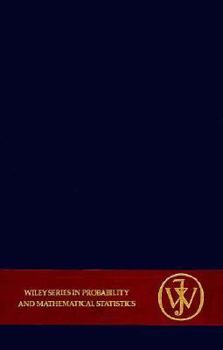Nonparametric Statistical Methods (Wiley Series in Probability and Statistics - Applied Probability and Statistics Section)
Select Format
Select Condition 
Book Overview
Praise for the Second Edition "This book should be an essential part of the personal library of every practicing statistician."--Technometrics Thoroughly revised and updated, the new edition of... This description may be from another edition of this product.
Format:Hardcover
Language:English
ISBN:047140635X
ISBN13:9780471406358
Release Date:March 1973
Publisher:Wiley
Length:528 Pages
Weight:1.92 lbs.
Dimensions:9.3" x 1.3" x 6.2"
Customer Reviews
4 ratings
Great Encylopedia
Published by Thriftbooks.com User , 16 years ago
This book is great for what it is - an encyclopedia for non-parametric methods. This isn't the text to read for an exposition about the development and all theory and proof behind the method (Lehmann is great for that) this is the place to go where you say my data has such and such a structure, and I have such and such hypothesis about it. This doesn't mean that this is a cookie cutter book - it provides the assumptions about each tests, the formulas for hand calculation (great for checking if the R function was coded correctly!), the relative efficiencies, info about ties and the asymptotics. as well as the notes at the end. In this sense it has something for must levels. I agree though the tables are a bit silly and the price is a bit high A couple of notes: 1) Some people have critiqued the structure - I actually like it but can see how it can be a bit confusing 2) The book is definitely about classic non-parametrics based on rank tests. There is much more to non-parametrics but this book fits a good niche If you are a practitioner who realizes ANOVAs are silly you will get something out of this book. And if you have a good understanding of theory it won't feel too dumbed down.
revision of a classic on nonparametrics
Published by Thriftbooks.com User , 17 years ago
In the 1970s this text became a classic on the subject of nonparametric methods. It was written for practitioners and students. It is introductory and comprehensive. It describes the methods accurately but does not cover the theory. Later Randles and Wolfe wrote a companion book covering the theory. This revision is much larger and covers the many advances over the past 20 years. It covers bootstrap methods as well. Also computational advances are discussed. Conover's "Practical Nonparametric Statistics" is another fine book for practitioners. I also recommend Lehmann's book on nonparametrics. It was published in 1975 and is not easy to find these days.
An excellent, encyclopediac approach
Published by Thriftbooks.com User , 26 years ago
This is an excellent book on a somewhat underutilized group of statistical techniques. It could be used for a course in nonparametric statistics at the graduate level in Psychology or the social sciences, although I don't think the whole book could be covered in a semester.It is perhaps more valuable as a reference for the practicing data analyst. Because of the format, it is relatively easy to find a procedure that does what you want. There are 11 chapters, the first of which is an introduction, and the others each cover one type of problem (e.g. the one-sample location problem). Within each chapter are a variety of procedures, each of which is discussed in the same format: Procedure, large-sample approximation, ties, example, comments, properties and problems. In addition, there are close to 200 pages of tables, many of which I haven't seen elsewhere.Overall, highly recommended for anyone who needs to use or teach these techniques.
A SUPERB Introduction- bound to be a Stat Classic
Published by Thriftbooks.com User , 26 years ago
I found this book to be very helpful and it required minimal interpretation from academia to understand. More so for the practicioner than the theoretician.





